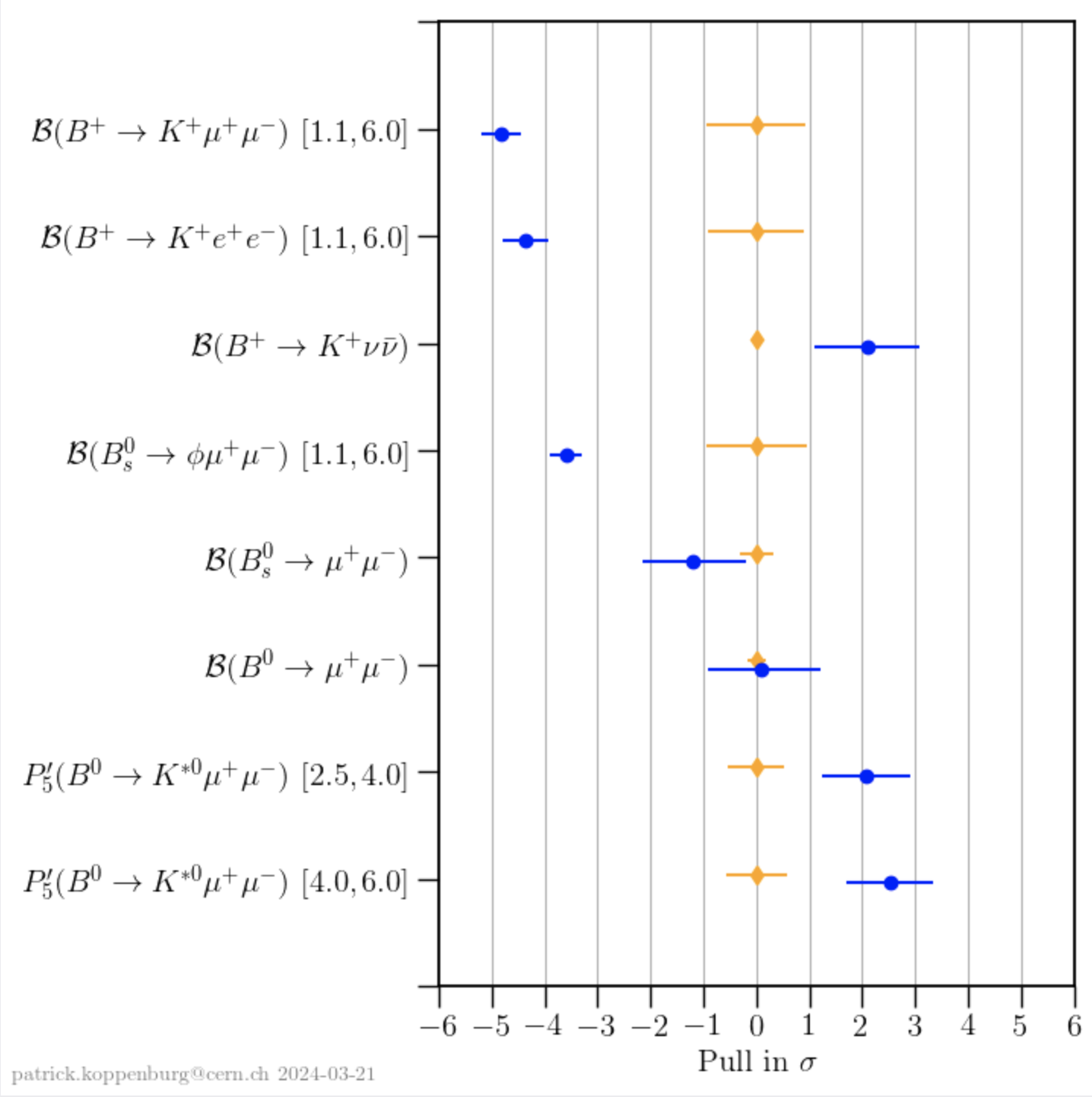Exploration with LHCb: from unseen to rare

Flavour physics, even at low-energy scales, offers a glimpse at energy scales far higher than those reachable directly thanks to the quantum loop effects, which are present in the quark transitions. The rarer or more suppressed a given transition is within the standard model (SM) of particle physics, the more prominent could be a modification of the rate of such a process thanks to the presence of new particles. The history of particle physics already has several examples of new particle discoveries thanks to studies of the so-called flavor-changing neutral currents (FCNC), forbidden at the tree level of the SM and proceeding through the higher-order loop diagrams. Such transitions, q→q'γ and q→q'l+l- (where l+l- is a pair of the same lepton flavour), continue to be leaders for exploration in the hunt for possible deviations from the SM prediction. In addition, separate attention is paid to the searches for the transitions forbidden in the SM or far from a current experimental reach, such as the lepton-flavour violating (LFV) q→q'l+l'-, as their observation would be a clear breakthrough.
While progressing with experimental exploration in this direction, the studied processes can transition from unobservable to being studied in great detail, revealing unexpected behaviour – which is precisely the goal of the presented approach. One of the evolving examples is the B0s→ϕμμ decay which has been discovered by the CDF experiment at the Tevatron. Its differential branching fraction, measured by the LHCb experiment, exhibits a 3.6σ tension with the theoretical prediction, being dominated by the theoretical uncertainties. Interestingly, a recently observed sibling transition B0s → f'2 (1525)μμ, with the same underlying quark process, broadly agrees with theory, with a caution that the precision in the corresponding theory calculation could still be improved.
This gives another motivation to the new searches and measurements in related rare decays, such as going beyond a flagship B0s →ϕγ radiative decay at LHCb, and looking at the B0s → K+K- γ system more generally. To disentangle various resonances contributions there and reliably estimate contributions from the misidentified hadrons backgrounds from B0→(Kπ)γ decays, an amplitude analysis is performed. By studying the two-dimensional distributions in the dikaon invariant mass and photon helicity angle plane, the contributions from the spin-1, spin-2 and spin-3 resonances can be quantified, and thanks to this, a decay B0s → f'2 (1525)γ via a tensor state is observed for the first time with a very high significance.
The same FCNC transition can be used to look for the LFV decay B0s → ϕμ±τ∓, the enhancement of which is motivated by persisting anomalies in the tree-level b→cτν transitions. It is also motivated by the 2.7σ deviation from the SM in the rate of the B+ → K+νν decay recently reported by the Belle II collaboration. Peaking backgrounds from the SM processes with a pion misidentified as a muon, which can mimic a signal are estimated using large data calibration samples, while smooth backgrounds from the random combination of tracks are modelled with various analytic shapes. The achieved upper limit on this LFV process is 1.1×10-5 at 95% confidence level, which is comparable to the other explored LFV modes with taus in the final state and the first constraint achieved using a b→s transition.

Plot showing the discussed flavour anomalies. The SM prediction is placed at zero. The experimental value is then offset its deviation from the SM in units of standard deviations. The quadratic sum of the uncertainties is unity. Figure from Patrick Koppenburg ("Flavour Anomalies").
Another news in the FCNC exploration by LHCb is the updated search for the Λc+→pμ+μ-, governed by the competing contributions from the short-distance c→ull process. This is expected to amount to about 10-8, and long-distance enhancements due to resonant processes of the order of 10-6, such as e.g. Λc+→pφ(→μ+μ-). To gain as much information as possible, the search is done in the bins of the dimuon invariant mass, which allows keeping under control resonant and non-resonant parts of the Λc+ decay. For the first time, a strong indication of a signal in a previously unobserved Λc+→pρ decay mode, and constraints at the level of 8×10-8 at the 95% CL are obtained.
Finally, the LHCb collaboration is paving the way towards measurements of rare fully leptonic B meson decays, such as B0s→4μ or B+→3μν, by observing and precisely measuring J/ψ→4μ, which is a more abundant electromagnetic decay with a similar final state. Thanks to the diverse trigger strategy employed at the LHCb, both promptly produced J/ψ mesons and those from the B meson decays are explored to enhance the sample size and to cross-check the results. In total, about 450 signal decays are studied, which allow validating both performances of the detector and Monte Carlo simulation for an underlying γ*→μμ transition, enhanced towards low dimuon mass. The obtained J/ψ→4μ branching fraction measurement is compatible with the available leading-order theoretical calculation and a result reported previously by the CMS collaboration based on 12 signal candidates. The importance of more credible Monte Carlo simulation for this and similar transitions is highlighted by comparing the observed invariant masses distributions of various muon combinations with those obtained in the analytical vs. simple phase-space models. This shows large differences between the two, with the analytical model being much more consistent with the observed data.

Summary of the measurements of the 𝐽/𝜓→𝜇+𝜇−𝜇+𝜇− branching fraction by the BESIII (upper limit at 90% CL) and CMS experiments, compared with the result presented by the LHCb experiment. The statistical uncertainties are shown in red, while the total uncertainties in blue.
As a conclusion, it is worth emphasising that all these new results are obtained with the data collected by the LHCb experiment up to 2018. A brand-new detector is recording proton-proton collisions happening at a rate up to factor 5 higher than previously, using significantly upgraded detector subsystems and a fully software-based trigger. Therefore, new surprises and achievements with the exploration of the rare decay programme might be coming very soon!
